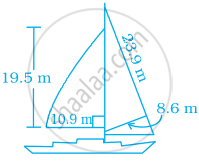Advertisements
Advertisements
प्रश्न
The diagonals of a rhombus are 18 cm and 24 cm. Find:
(i) its area ;
(ii) length of its sides.
(iii) its perimeter
उत्तर
The diagonal of the rhombus is 18 cm and 24 cm.
area of rhombus = `1/2` x Product of diagonals
= `1/2` x 18 x 24
= 216 cm2
(ii)
Diagonals of a rhombus bisect each other at right angles.

∴ OA = `1/2 xx 24 = 12` cm
OB = `1/2 xx 18 = 9` cm
In right ∠d Δ AOB
AB = `sqrt("OA"^2 + "OB"^2)`
= `sqrt((12)^2 + (9)^2)`
= `sqrt(144 + 81)`
= `sqrt(225) = 15` cm
∴ Side of rhombus = 15 cm
(iii)
Perimeter of rhombus = `4 xx "side"`
= `4 xx 15 = 60` cm
(i) 216 cm2 (ii) 15 cm (iii) 60 cm.
APPEARS IN
संबंधित प्रश्न
Lengths of the diagonals of a rhombus are 16.5 cm and 14.2 cm, find its area.
Each side of a rhombus is 18 cm. If the distance between two parallel sides is 12 cm, find its area.
A sweet is in the shape of rhombus whose diagonals are given as 4 cm and 5 cm. The surface of the sweet should be covered by an aluminum foil. Find the cost of aluminum foil used for 400 such sweets at the rate of ₹ 7 per 100 sq.cm
The area of the rhombus when both diagonals measuring 8 cm is
The angle between the diagonals of a rhombus is
One of the diagonals of a rhombus is thrice as the other. If the sum of the length of the diagonals is 24 cm, then find the area of the rhombus.
A man has to build a rhombus shaped swimming pool. One of the diagonal is 13 m and the other is twice the first one. Then find the area of the swimming pool and also find the cost of cementing the floor at the rate of ₹ 15 per sq.cm
Area of a quadrilateral ABCD is 20 cm2 and perpendiculars on BD from opposite vertices are 1 cm and 1.5 cm. The length of BD is ______.
Area of a rhombus = `1/2` product of ______.
Most of the sailboats have two sails, the jib and the mainsail. Assume that the sails are triangles. Find the total area sail of the sailboats to the nearest tenth.

